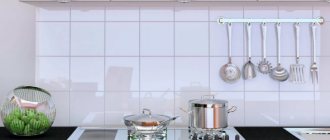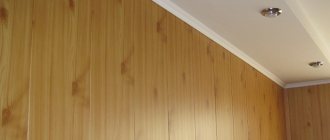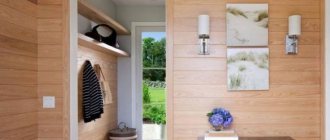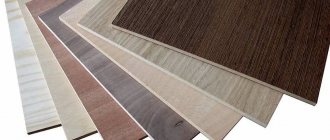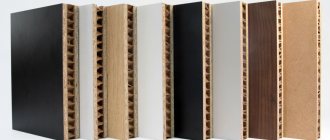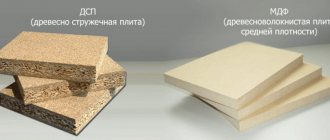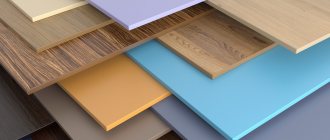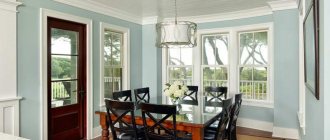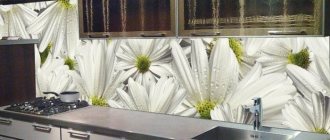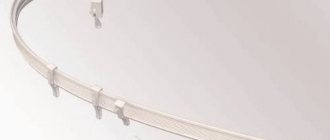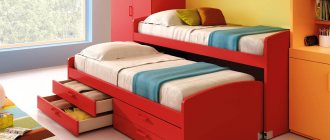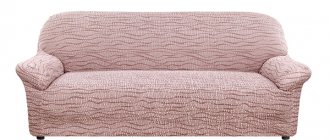What is better for the kitchen: MDF or laminated chipboard is a controversial issue. When arranging a kitchen, it is important to take into account a large number of nuances, one of which is the quality of the material for making furniture. Since not all people have the opportunity to purchase products made from natural solid wood, they have to look for a budget replacement.
The most popular materials are MDF and chipboard. At first glance they are similar, but in fact they differ in production technology and some properties. Today we will look at the positive and negative qualities of these panels.
MDF or chipboard for the kitchen: which is better?
Kitchen furniture: features
Quite often, well-known manufacturers prefer to use MDF and laminated chipboard when creating kitchen furniture. At the same time, serious requirements are placed on products installed in premises of this type - they must withstand temperature changes, high humidity and other negative influences. The materials we are considering are believed to have similar properties.
It is worth noting that most consumers consider the quality of furniture last. For many, appearance always comes first. Nevertheless, quality is a very important criterion, because the durability of the kitchen, aesthetics, and the general perception of the room depend on it.
Kitchen furniture must be reliable
In addition, kitchen furniture must remain in its original form, even despite frequent washing with chemicals and the negative effects of temperature and humidity. If the set does not meet these criteria, then in the first year the owners will be disappointed in the purchase, and the question will arise about renovating or buying a new kitchen. Of course, no one would want this, and therefore we recommend that you read this text carefully so as not to make a mistake with your choice.
Installation methods
Installation of panels does not require special skills. Installation conditions depend only on the method of its implementation.
On the frame
The frame method is used for large uneven walls; in wet rooms, galvanized guides should be chosen. This method allows for additional insulation and soundproofing of the room.
Frame mounting is used for uneven walls.
On glue
Installation using glue is carried out in rooms where space needs to be preserved. It is first necessary to level the surface, remove roughness, and seal cracks. After preparation, the wall is treated with a primer. Then glue is applied pointwise to the back side of the tile.
The panel with the composition is placed on the wall and held for several seconds, pressed tightly to the surface.
What is MDF?
MDF was first invented in America back in the 60s of the last century, and in Russia this material appeared only in the late 90s. MDF boards are made from wood chips, ground into very small chips - it is practically split into fibers. Then these chips are thoroughly washed, excess dirt is removed, dried, and then pressed under high pressure.
As the fibers heat up, they begin to release a natural resin called lignin. It is this substance that glues the chips together, resulting in very strong slabs with a fine structure.
MDF board manufacturing process
The pressed slabs are then carefully sanded - this is done in order to remove any excess sagging from the surface. In addition, at this stage, panels of various thicknesses are formed. After which the surface of the slabs undergoes finishing treatment, which allows you to obtain a wide variety of materials for work.
Table 1. Types of MDF finishes
| Type | Description |
| Sanded | Sand only one side of the slab or two at once. Putty and various types of paint can be applied on top of such material. This is the simplest and most common type of MDF, allowing the buyer to decide on the finish of the slab. |
| Laminated | A special polymer film is applied to the surface of the plate. In this way, only one side or both are processed. The film has an aesthetic appearance that imitates the structure of various types of natural wood, which is why such boards have become especially popular among furniture makers. |
| Veneered | A thin layer of natural wood is glued on top of the slabs, so that the appearance of such material becomes similar to natural wood. Of course, due to such processing, MDF acquires a higher cost, but greater attractiveness and nobility. |
| Varnish coating | A thick layer of varnish is applied to the slab, making the material resistant to moisture. However, this is not the best option for the kitchen, because fingerprints will constantly appear on the surface. |
MDF kitchen set
The main advantages of MDF include the following:
- Safety for the health of residents, because in the process of its production no harmful chemical compounds or formaldehydes are used.
- It has good resistance to various mechanical damage.
- The furniture is easy to care for - this material has a smooth surface that does not absorb dirt.
- Resistance to high air humidity.
- This material is not affected by fungi.
- Easy to process even at home - MDF can be used to make structures of any shape.
- You can find a wide variety of colors of MDF boards on sale, which allows each person to choose the best option for themselves.
There are a large number of MDF colors.
There are also some disadvantages of this material:
- The obvious disadvantage is the rather high cost of the material, but it is still lower than that of natural wood.
- Some note that when exposed to too much heat, MDF can separate into layers, so it should be protected from such negative effects.
- Furniture does not react well to aggressive alkali.
- Untreated surfaces have poor resistance to moisture. Thus, the material absorbs water, which is why it begins to swell after some time.
- Scratches appear quickly on glossy surfaces, so it is not recommended to use metal brushes for cleaning. A problem that has already appeared can only be corrected by painting, and the entire surface will have to be painted.
- Due to constant fumes in the kitchen, the varnished countertop becomes faded and matte.
- After some time, the material will still lose its original strength, which can cause cabinet fittings to become loose.
Video - Veneer facades for the kitchen
The facade is the face of your kitchen. Frame and veneered facades
What are facades made of framed MDF?
As the name suggests, this type of facade consists of a frame and filling (panel). The frame itself is a molded MDF profile. This MDF profile for frame facades is wrapped in melamine paper, PP film, PVC and veneer from leading suppliers of decorative coatings (Pfleiderer, Kroning, Schattdecor, Renolit, Interprin, etc.).
Frame fronts are an interesting and versatile way to give your kitchen a unique homely atmosphere. These facades will be of interest to those who want to buy a kitchen inexpensively, having the opportunity to create their own unique design. This is solved due to the widest range, which allows you to create hundreds of combinations of fillings and frame colors. Today, the warehouse base of facing materials includes more than 120 decors.
One of the criteria that favorably distinguishes facades made from framed MDF profiles, for example, from MDF facades wrapped in PVC film, is their practicality and resistance to high temperatures, and the environmental friendliness of the materials used. Frame facades are protected by layers of varnish, and when processing facades that are not painted, the so-called thermal seam is used.
The production of facades from framed MDF profiles is equipped with the latest woodworking equipment from leading manufacturers. So, for cutting MDF and chipboard materials, Holzma machines are used. On the machines of the Spanish company Barberan, molded products are faced, as well as the decorative coating is cut to the required width. Milling of profiles is carried out using equipment from companies such as Weining (Germany) and SCM (Italy). Martin format saws from the German manufacturer Otto Martin Mashinenbau produce high-precision cutting of slab material with a high level of accuracy. Thanks to such equipment, producing high-quality kitchens with framed MDF facades is the norm.
For clients who choose natural materials, we have also provided an interesting solution - facades made of chipboard, lined with natural veneer. During production, veneer is used in both its natural shades and those impregnated with dye (to create fantasy solutions). On top, these facades are coated with glossy or matte varnish. These facades are highly resistant to damp and other aggressive environments, and thanks to natural veneer, a complete illusion is created that the kitchen is made of natural wood.
What is chipboard?
The first chipboards went on sale back in the 18th century. Of course, they were not of high quality, but in subsequent years this material was significantly improved. This type of particle board has several manufacturing stages:
Step one: processing of natural wood and procurement of raw materials. Laminated chipboard is made from large sawdust, and then the workpiece is ground to obtain a finer fraction.
First of all, sawdust is prepared
Step two: drying the sawdust. The resulting small chips are sent to special equipment, where they are dried under the influence of air.
Drying raw materials
Step three: the raw materials go through the selection stage. Thus, only small chips go into production, and large pieces of wood are crushed again.
Sorting of raw materials
Step four: mixing with additional component. At this stage, synthetic formaldehyde resin is added to the shavings for better bonding.
Formaldehyde resin
Step five: forming the workpiece. The mixture of resin and chips enters the conveyor, where rough slabs are formed in several layers using cold pressing.
This is what the slab blanks look like
Step six: the surface of these plates is carefully sanded. In order to give the material a decorative appearance (as in the case of MDF), a special polymer film is applied to the surface.
Film application process
Next, all that remains is to cut the slabs into standard sizes. After which they are sent for sale.
The following advantages of laminated chipboard are highlighted:
- Budget cost compared to natural solid wood and even MDF.
- Good resistance to temperature changes and high humidity.
- Large selection of different colors. As with MDF, chipboard has a huge variety of laminated surfaces.
- The material does not deform as a result of mechanical damage.
- While ordinary chipboard quickly deteriorates, laminated boards are durable.
- The material has good scratch resistance. In addition, it can be cleaned with various chemicals.
Laminated chipboards are sold in various shades.
Among the disadvantages of the material, the following can be noted:
- The boards are quite rigid compared to MDF, which means they are less easy to process. It turns out that it is difficult to make shaped structures from such material.
- This material often chips at the edges during cutting, so it is best not to cut it with a regular handsaw.
- The composition contains dangerous formaldehydes - this is the point that can negate any positive qualities of laminated chipboard.
When sawing, chips often occur.
Despite such significant shortcomings, not everything is so bad. After all, there are two types of laminated chipboard: marked E1 and E2. In the first case, 10 grams of toxic resin are added per hundred grams of shavings; in the second case, the amount of formaldehyde for the same mass of sawdust exceeds 30 grams.
Therefore, if you have already decided to use laminated chipboard to make furniture, then you should only choose the option marked E1, because it is relatively safe.
Step-by-step instruction
Installation of sheets is glue-based and does not require much time. Cladding walls onto a frame is a more labor-intensive process, but even an inexperienced craftsman can handle it by following simple recommendations.
Preparatory activities
Before installation on the frame, a special structure must be installed. The lathing is made of a metal profile or wooden beam (side length 30 mm and humidity no more than 15%). Before installation, the wood is treated with a bioprotective impregnation.
To carry out the work you will need the following tools: tape measure, level, electric jigsaw or hacksaw, screwdriver, hammer or stapler.
To carry out the work you will need an electric jigsaw.
Installation of guides depends on the location of the panels. In the case of vertical installation, the sheathing elements are attached horizontally to the wall, i.e. perpendicular to the canvas. In other orientations, the installation is carried out in reverse.
Execution of work
Work order.
- Measuring and marking the wall (distance between guides 50-60 cm).
- Attaching the profile to the surface. The first rail is installed at the junction of 2 walls. It is attached to a concrete or brick surface using dowels, and to a wooden surface with self-tapping screws.
- Between the frame elements, additional wall insulation is made, for example, mineral wool is laid.
- The starting panel is mounted in a corner and secured with self-tapping screws to the guide. On the opposite side, clamps are inserted into the groove at the intersection with the slats and secured with nails or staples.
- The tenon of the next lining is driven into the groove of the previous one and fixed with clamps.
- The last sheet is cut so that it fits freely into the groove of the previous one and there is a gap of 5 mm to the wall. Complete the fixation with a self-tapping screw.
Which material is suitable for kitchen furniture: comparison
To understand whether it is better to buy furniture made from laminated chipboard or MDF for the kitchen, you need to compare their positive and negative qualities.
Durability
Of course, when purchasing various pieces of furniture for the kitchen, we plan to use them for many years in a row, so it is necessary to choose the most durable material. As we mentioned above, low-quality furniture will quickly become unusable, and the kitchen will have to be replaced every two or three years, which is completely unprofitable.
MDF has better wear resistance
Furniture made from MDF is characterized by the highest durability (this feature is due to the almost natural composition of this material), and structures made from laminated chipboard will quickly lose their original appearance. If you provide good care for MDF furniture, it will definitely serve you for many years.
Resistance to various damages and negative impacts
Kitchen furniture must be resistant to various impacts and other damage. Of course, products made from MDF have better resistance to wear and oil stains. However, such a surface will suffer from constant exposure to steam or any liquid, and this will become noticeable within a few years. Furniture made from chipboard is less likely to deform under such conditions.
Laminated chipboard is stronger due to the synthetic resin in its composition
Otherwise, I would like to note that furniture deteriorates and breaks with equal frequency due to various mechanical damages, so it is difficult to select the best of the two materials. Note that laminated chipboard has a higher resistance to scratches, moreover, these surfaces can be washed without fear even with strong chemicals.
Environmental Safety
The content of toxic components in the composition negatively affects human health, so this point cannot be ignored. And since laminated chipboard still contains formaldehyde, albeit in small quantities (E1), purchasing such furniture is a risk, especially if kitchen furniture is made from it. Therefore, despite the large number of positive qualities, many refuse this lumber.
Chipboards may have a specific odor due to formaldehyde
Note! We should take a short digression to understand how synthetic resin affects health. This poison affects the nervous system, respiratory organs, liver, and kidneys. In addition, the substance irritates the mucous membranes of the eyes and provokes an allergic reaction.
The use of MDF in the kitchen, in turn, does not in any way affect people’s well-being, so if we evaluate materials on this point, then MDF is clearly the leader.
Aesthetic features
The attractive appearance of a kitchen is sometimes the main criterion by which it is chosen. Here, the two materials we are considering do not have any particular advantages over each other, since the modern furniture industry offers a lot of kitchen models made from both MDF and laminated chipboard. The choice is always a matter of taste, so for each buyer the conclusion about the external attractiveness of such furniture will be individual.
An example of an aesthetic kitchen made from chipboard
But, if you want to purchase a kitchen with various shaped elements, then of course you should choose MDF - laminated chipboard, due to its greater rigidity, is not suitable for the manufacture of such furniture elements. I would also like to note that laminated chipboard has a wide variety of shades, and if you are looking for furniture in bright or unusual colors, then you should take a closer look at this material.
Aluminum frame facades
Frame structures based on aluminum profiles are most often made for glass kitchen facades. Less often, other fillers are inserted into such a frame, but this depends solely on the taste and wishes of the owners. Otherwise, this is a universal solution in its characteristics.
The photo shows a bright kitchen using an aluminum frame profile
Advantages of aluminum frames:
- high strength of finished products;
- durability and wear resistance;
- moisture and heat resistance;
- compatibility with any filling ─ glass, rattan, etc.;
- Possibility to paint metal in any color.
Disadvantages of aluminum frames:
- scratches are clearly visible on such facades;
- The complete set of aluminum frames with glass includes only special fastenings and handles;
- manufacturing, repair and replacement cannot be done by hand.
How do the plates differ in appearance?
You can notice the differences between laminated materials only by their edges. Thus, MDF has a smaller and denser structure, while laminated chipboard has rough shavings visible on the cut. On the surface of chipboard without any treatment, you can notice the presence of large wood fibers.
In addition, if you cut two boards of the same shape and thickness, you will notice that the MDF will be a little lighter.
Lumber cutting
If pieces of furniture have carved parts, then we can say with confidence that this is MDF. Even a professional will not be able to cut out such elements from a material such as chipboard, because it will simply crumble during the work.
Popular manufacturing companies
The reputation of a company engaged in the production of building boards is influenced by the quality of products, their range, compliance with international standards, compliance with environmental standards, and the use of innovative technologies. Popular companies include:
- Austrian company Egger. Offers more than 230 types of various decor, incl. stylization of natural marble and other rocks, as well as 12 shades of white.
- Swiss concern SWISS KRONO. It has production facilities in different countries, incl. Russia. The color range of design solutions has more than 170 types.
- Belgian company Spanolux. It produces slabs for various purposes and compositions (fire-resistant, moisture-resistant, lightweight, etc.). Cladding is carried out at the customer's choice.
- Austrian company Kronospan. Manufactures products for furniture factories, construction and finishing works.
- Russian holding Soyuz. It has 2 directions: for furniture production and creation of decorative finishing of premises. Cheaper than European analogues.
- Russian enterprise Kastamonu. The plant has a full production cycle, which reduces the cost of the final product.
Is it possible to combine materials?
Often, in order to reduce the cost of products, manufacturers combine different materials. Basically, MDF is used to make cabinet doors, while chipboard is best suited for the frame. Nowadays, it is almost impossible to find such cabinets, the frame of which consists of finely divided material - the fact is that such structures will be too expensive.
Materials do not exclude the option of combining
The choice of material depending on the kitchen design
Depending on the design of the overall kitchen interior, various lumber is used. Of course, the visual differences between laminated chipboard and MDF are small, but designers have the following opinion regarding the style of the kitchen and the materials for it:
- Classical. In this case, it is better to give preference to untreated MDF boards, since they can be painted independently and given an unusual appearance using the patina technique.
- Art Deco. Since the quality of the glossy surface of laminated chipboard is slightly better, it is recommended to use this material. However, MDF is also perfect for such an interior.
- High tech. Since this style does not have various figured facades, it is quite possible to use laminated chipboard.
- Provence. As in the case of the classic style, finely dispersed material for painting is most suitable.
MDF kitchen in classic style
General requirements for the use of furniture
Despite the fact that manufacturers promise that kitchens are resistant to high temperatures, you should not expose furniture made from MDF or laminated chipboard to temperatures exceeding 75 degrees. Due to this impact, the surface may be deformed, so it is not recommended to place heating devices on the countertop.
If the kitchen set is constantly exposed to sunlight, then after a few months it may become pale (this is especially true for furniture made of laminated chipboard). You should not allow the slabs to be regularly soaked in water - in such conditions, even the most durable material will rapidly swell.
You will need to keep surfaces clean
The following surface care rules must be followed:
- It is advisable to regularly wipe the furniture with a dry cloth to remove dust; in addition, you can purchase a special product for delicate cleaning;
- if water gets on the surface, it should be removed as quickly as possible with a well-absorbing cloth;
- You should not use wax for such materials, which is used to polish natural wood - it will not be absorbed and will remain in a greasy layer.
MDF and laminated chipboard react poorly to wax intended for solid wood. If this rule is neglected, the laminated surface may become stained and even deformed. When cleaning, you should not use various products with a high acid content.
MDF kitchen combined with living room
Since both materials are resistant to fungi, furniture can stand in dry rooms for many years, and no additional treatment is required in this case.
If you don’t know what to put and where, how to place a set with everything you need in a small kitchen, we advise you to carefully study the special article and then apply the knowledge gained from it in practice.
Let's sum it up
So, we have assessed all the main advantages and disadvantages of MDF and laminated chipboard. We can conclude that MDF boards are more environmentally friendly, and if your financial capabilities allow, then do not skimp on purchasing such furniture.
If you only have a limited budget for furnishing your kitchen, then it is advisable to buy furniture made from chipboard. However, you should avoid purchasing hazardous material marked E2 - it is absolutely not suitable for making kitchen furniture.
